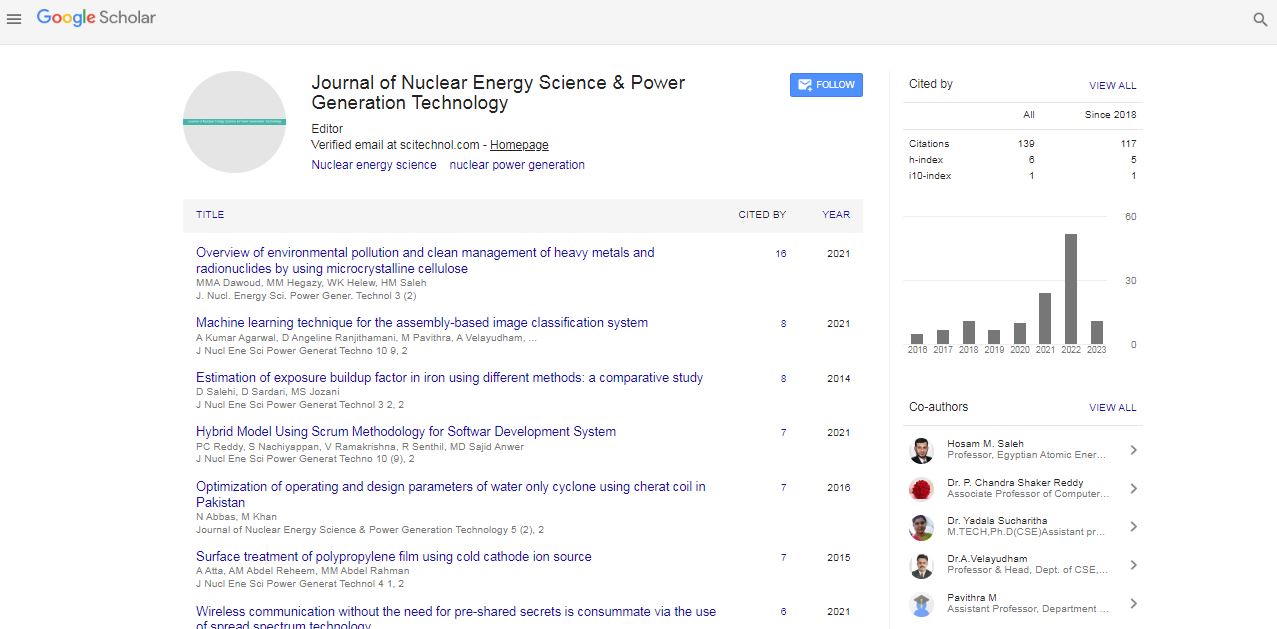Perspective, J Nucl Ene Sci Power Generat Technol Vol: 12 Issue: 2
Nuclear Science in Medicine: Revolutionizing Diagnosis, Treatment and Drug Development
Mark Becker*
Department of Nuclear Engineering, Texas A&M University, Texas, USA
*Corresponding Author: Mark Becker,
Department of Nuclear Engineering, Texas A&M University, Texas, USA
E-mail: markbecker@uni.edu
Received date: 27-Mar-2023, Manuscript No. JNPGT-23-95570;
Editor assigned date: 29-Mar-2023, PreQC No. JNPGT-23-95570 (PQ);
Reviewed date: 13-Apr-2023, QC No. JNPGT-23-95570;
Revised date: 21-Apr-2023, Manuscript No. JNPGT-23-95570 (R);
Published date: 01-May-2023, DOI: 10.4172/2325-9809.1000330.
Citation: Becker M (2023) Nuclear Science in Medicine: Revolutionizing Diagnosis, Treatment and Drug Development. J Nucl Ene Sci Power Generat Technol 12:2.
Description
Nuclear science, a field that studies the behavior and properties of atomic nuclei, has been instrumental in revolutionizing various aspects of medicine. From diagnosis to treatment, nuclear science has made significant contributions to the field of medical imaging, radiation therapy, and drug development.
Medical imaging
Medical imaging plays a crucial role in the diagnosis and management of various medical conditions. Nuclear science has provided several imaging techniques that have significantly improved the accuracy and early detection of diseases. One such technique is nuclear medicine, which involves the use of radioactive substances to create images of internal organs and tissues.
In nuclear medicine, a small amount of a radioactive substance, known as a radiotracer, is administered to a patient either orally, intravenously, or through inhalation. The radiotracer accumulates in the targeted organ or tissue, emitting gamma rays that can be detected by a gamma camera. The gamma camera creates an image of the distribution of the radiotracer in the body, providing valuable information about the function and metabolism of organs and tissues. Nuclear medicine is commonly used for imaging the heart, brain, thyroid, bones, and other organs, aiding in the diagnosis of conditions such as cancer, cardiovascular diseases, and neurological disorders.
Advancements in nuclear imaging have also led to the development of hybrid imaging techniques, such as Single-Photon Emission Computed Tomography (SPECT). These combined techniques merge the functional information obtained from nuclear imaging with the anatomical details from Computed Tomography (CT) scans, providing more precise and comprehensive diagnostic information.
Radiation therapy
Radiation therapy, also known as radiotherapy, is a common treatment modality for cancer. Nuclear science has played a pivotal role in advancing radiation therapy techniques, making them safer and more effective. Radiation therapy uses high-energy radiation to destroy cancer cells and shrink tumors.
One of the major advancements in radiation therapy is Intensity- Modulated Radiation Therapy (IMRT), which uses computercontrolled linear accelerators to deliver precise and highly conformal doses of radiation to the tumor while sparing adjacent healthy tissues. IMRT allows for the customization of radiation dose distribution according to the shape, size, and location of the tumor, resulting in improved tumor control rates and reduced side effects.
Another notable advancement in radiation therapy is Proton Beam Therapy, which uses protons, positively charged particles, to deliver radiation to tumors. Protons have unique properties that allow for precise targeting of the tumor while minimizing radiation exposure to surrounding healthy tissues. Proton Beam Therapy is particularly beneficial for treating tumors in sensitive areas such as the brain, spine, and pediatric cancers, where minimizing radiation damage to nearby healthy tissues is crucial.
Nuclear science has also contributed to the development of molecular radiotherapy, also known as targeted radionuclide therapy. This approach involves the use of radiolabeled molecules that specifically target cancer cells, delivering radiation directly to the tumor while sparing healthy tissues. This has shown promising results in the treatment of various types of cancer, including neuroendocrine tumors, lymphomas, and bone metastases.
Drug development
Nuclear science has also played a critical role in drug development and research. Radiopharmaceuticals, which are radioactive compounds used in nuclear medicine, have been instrumental in understanding drug metabolism, pharmacokinetics, and receptor binding studies. Radiolabeling of drugs with radioactive isotopes allows for tracking and quantification of drug distribution in the body, providing insights into drug behavior and efficacy. Nuclear science has also been utilized in the production of radioisotopes for medical use. Cyclotrons and nuclear reactors are used to produce radioisotopes that are used in various imaging and therapeutic applications.
Safety and regulations
The use of nuclear science in medicine is highly regulated to ensure safety for patients, healthcare workers, and the environment. Strict guidelines and regulations are in place to govern the production, handling, and disposal of radioactive materials used in medical applications. Radiation protection measures, such as shielding, monitoring, and dose optimization, are employed to minimize radiation exposure to patients and healthcare workers. Radiation safety protocols are strictly followed to prevent accidental exposures and ensure safe handling of radioactive materials.
Conclusion
Nuclear science has revolutionized the field of medicine by providing invaluable tools and techniques for diagnosis, treatment, and drug development. Nuclear imaging has greatly improved the accuracy of disease detection, while radiation therapy has become more precise and effective in treating cancer. The use of radiopharmaceuticals and radioisotopes in drug development has also advanced our understanding of drug behavior and efficacy. However, it is important to ensure strict adherence to regulations and guidelines to maintain safety in the use of radioactive materials in medicine.
As technology continues to advance, nuclear science is expected to further contribute to the field of medicine, paving the way for more effective and targeted treatments for various diseases. The ongoing research and advancements in nuclear science hold promise for the future of medical applications, and continued collaboration between nuclear scientists, medical professionals, and regulatory bodies will further drive innovations in this field.
 Spanish
Spanish  Chinese
Chinese  Russian
Russian  German
German  French
French  Japanese
Japanese  Portuguese
Portuguese  Hindi
Hindi 

